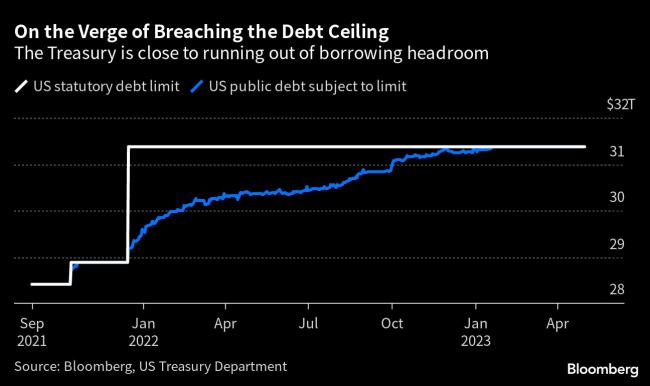(Bloomberg) -- Investor concerns around the US debt ceiling ebbed further on Wednesday as the deal struck by President Joe Biden and Speaker Kevin McCarthy headed toward a vote in the House of Representatives after clearing a crucial procedural hurdle with days remaining to avoid a calamitous default.
The cost of insuring US sovereign debt against default via derivatives has tumbled. At one point this month it exceeded levels on the bonds of many emerging markets with credit ratings well below that of the world’s biggest economy. Yields on Treasury bills maturing in early June — when Treasury Secretary Janet Yellen has said her department risks running out of cash — also extended their decline for the most part amid optimism around the agreement to avoid breaching the $31.4 trillion debt limit. Bills due June 6 yielded 5.17%, down from more than 7% at one point last week.
Meanwhile, the amount of money the US government has to pay its bills rebounded slightly at the end of last week, according to data released Tuesday. The Treasury’s cash pile, which had dwindled to the lowest level since 2017, climbed on Friday, giving the administration a little more breathing room under the statutory debt limit. But until the debt-cap accord is fully implemented, the Treasury is maneuvering on the assumption that the government could still exhaust its borrowing authority.
Congress is racing to approve the measure before June 5, the date Yellen has warned the US risks default. While leaders in both parties face members who oppose concessions made by negotiators in the compromise unveiled over the weekend, although there are signs of growing momentum behind the legislation.
From Washington to Wall Street, here’s what to watch to gauge how sentiment is shifting.
The Bills Curve
Investors have historically demanded higher yields on securities that are due to be repaid shortly after the US is seen as running out of borrowing capacity. That puts a lot of focus on the yield curve for bills — the shortest-dated Treasuries. Noticeable upward distortions in particular parts of the curve tend to suggest increased concern among investors that that’s the time the US might be at risk of default. That had been most prominent around early June, but yields on those maturities have eased since the Biden-McCarthy deal was announced, suggesting investors are less concerned about the threat of missed payments. While Treasury’s bill auction announcement on Tuesday confirmed that the government would be able to auction and settle new issues on time, it didn’t guarantee securities maturing on June 6 would be redeemed “on a timely basis,” according to Wrightson ICAP (LON:NXGN).
The Cash Balance
The amount that sits in the US government’s checking account fluctuates daily depending on spending, tax receipts, debt repayments and the proceeds of new borrowing. If it gets too close to zero for the Treasury’s comfort could still be a problem until the legislation is passed. As of Friday there was close to $55 billion left, up from the day before. Investors will watch each new release on that figure carefully. Focus is also on the so-called extraordinary measures that the Treasury is using to stretch out its borrowing capacity. As of the middle of last week that was down to $67 billion.
On Wednesday, the Treasury said it plans to sell an unusually short-dated bill on Thursday — $25 billion of three-day cash management bills.
Insuring Against Default
Beyond T-bills, another key area to watch for insight on debt-ceiling risks is what happens in credit-default swaps for the US government. Those instruments act as insurance for investors in cases of non-payment. The cost to insure US debt has retreated, but at one point it was higher than the bonds of many emerging markets that have credit ratings well below that of the US.
Rating Companies
Hovering over the whole debt-ceiling fight, meanwhile, is the risk that the major global credit assessors might choose to change their views on the US sovereign rating. Fitch Ratings recently issued a warning that it could opt to cut the country’s top credit score, a market-roiling step that Standard & Poor’s took during the 2011 debt-limit fight. This time around both S&P and Moody’s Investors Service have refrained from shifting their outlooks, although that is potentially a risk and investors will be clued in to anything the major rating companies might say about the situation, even if an agreement is concluded.
©2023 Bloomberg L.P.
